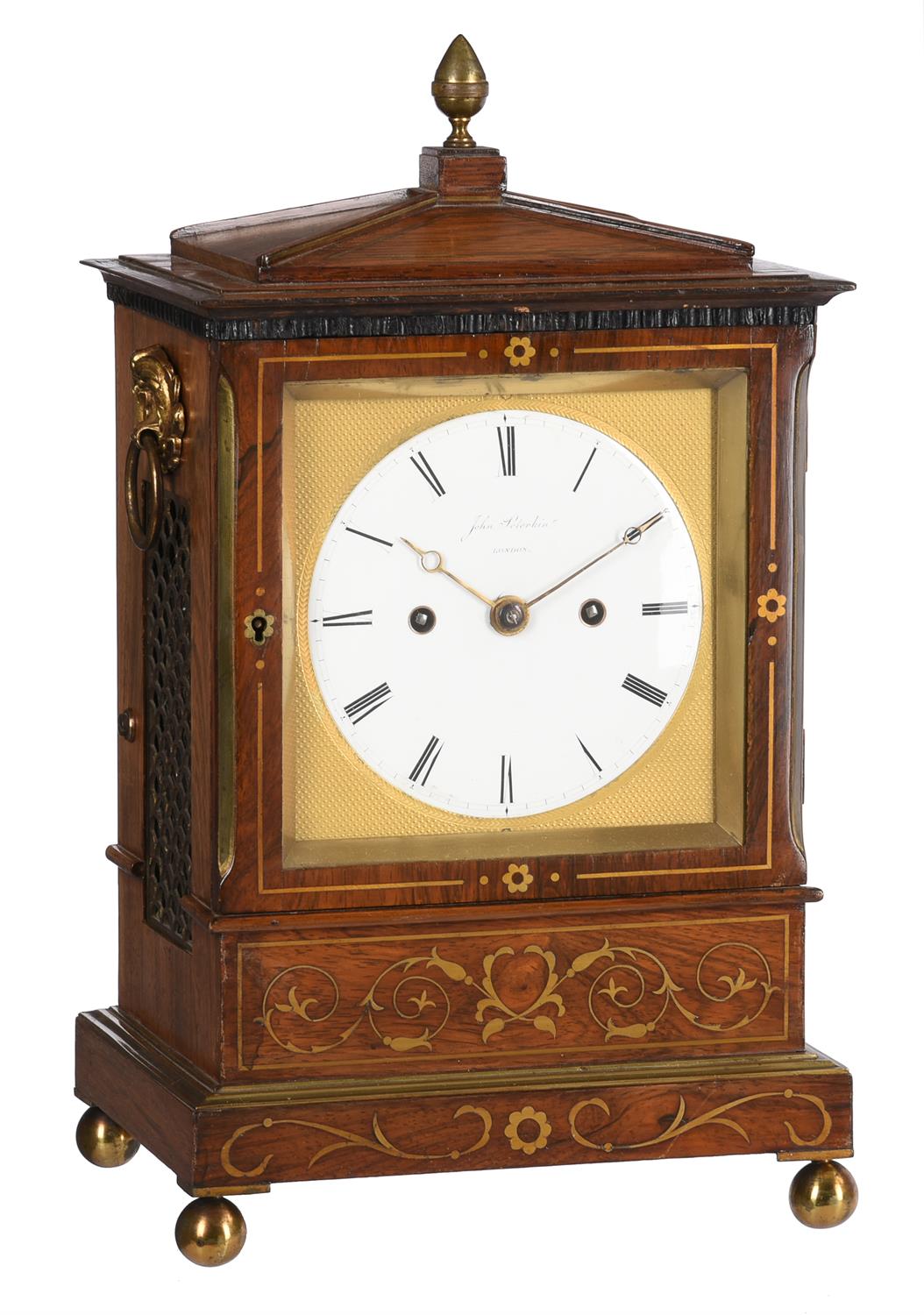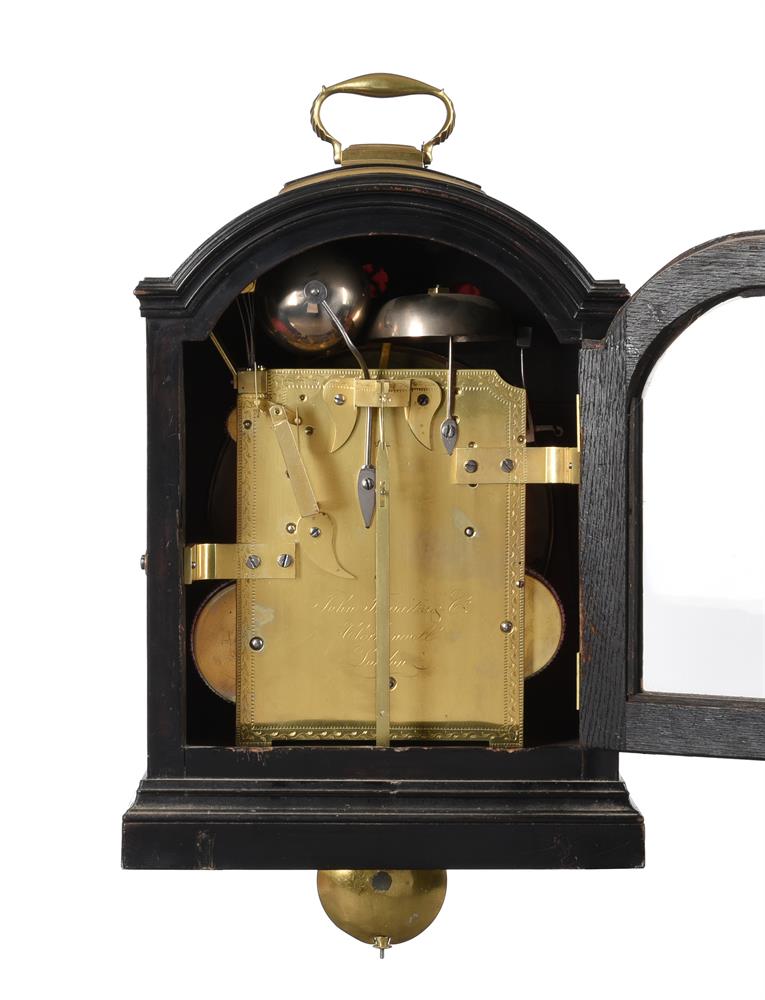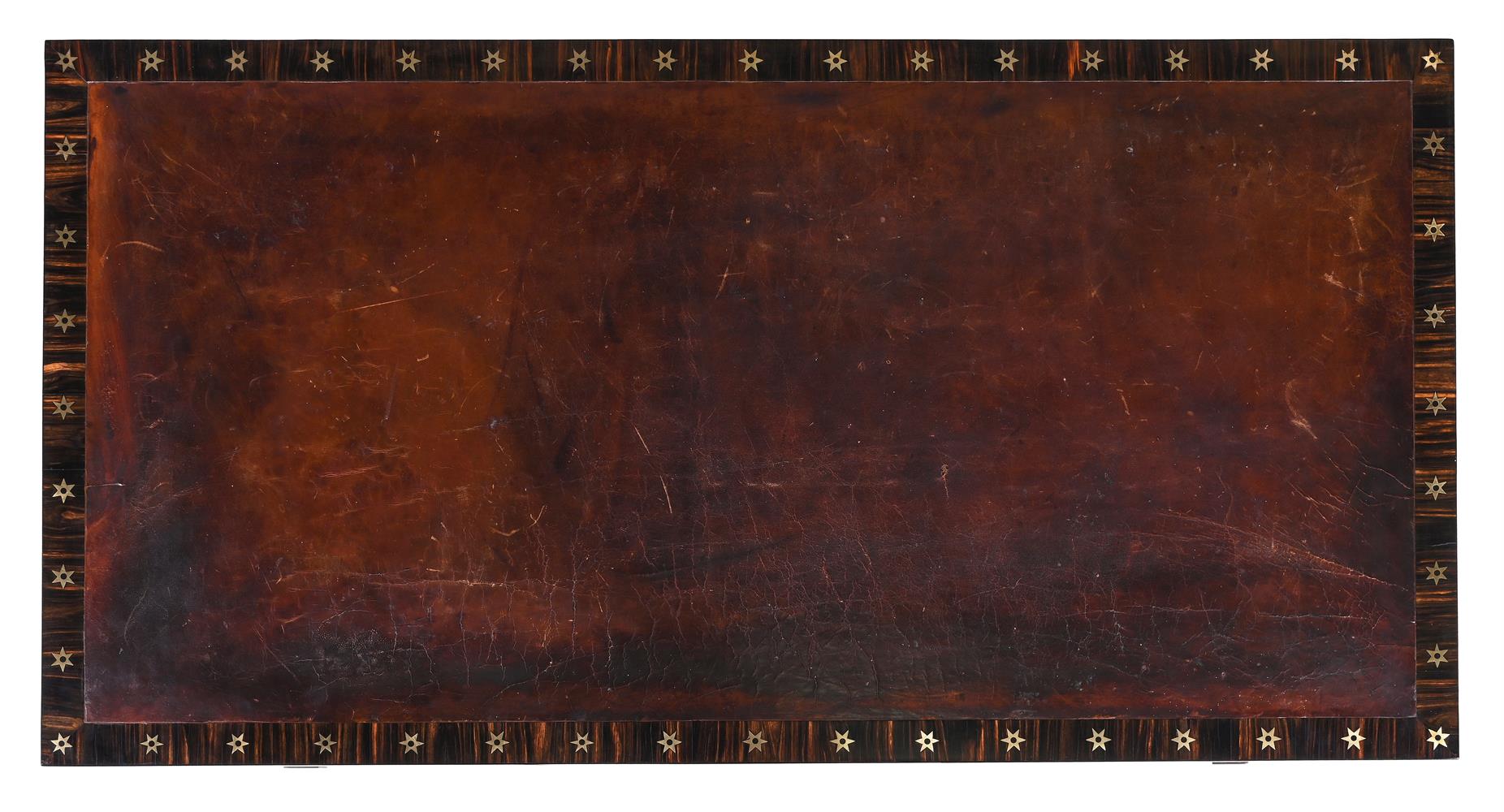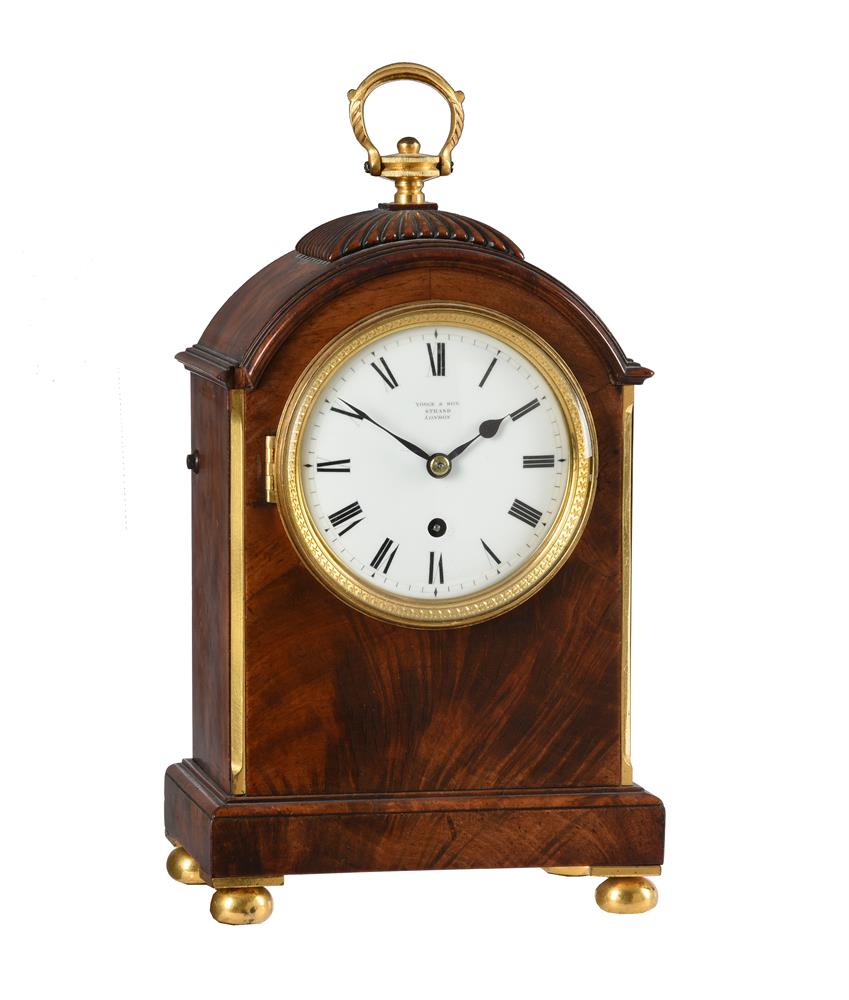A fine Regency brass mounted ebonised bracket timepiece supplied to H.M. Government Committee of Transports Navy Office, Whitehall Thwaites and Reed, London, circa 1817 The substantial five pillar single fusee movement with anchor escapement regulated by heavy lenticular bob pendulum, the shouldered backplate engraved Thwaites & Reed, LONDON, Committee of Transports, Navy Office within fine repeating stylised leaf engraved border, the frontplate stamped T & R over serial number 5959, the 8 inch slightly convex cream painted Roman numeral dial signed Thwaites & Reed, LONDON beneath crown and G V R cypher to centre, with minute track to outer margin and pierced blued steel hands, the ebonised break-arch case with hinged carrying handle to the brass fillet edged single pad top over slender cavetto cornice moulding and front door incorporating crescent-shaped scroll pieced brass fret above convex glazed cast circular bezel and conforming lower quadrant frets with raised half-round moulded surrounds, the sides with arched brass fishscale frets, the rear with arched blind panel door set within the frame of the case, on cavetto moulded skirt base resting on original wall bracket with complex moulded border to the table over brass bound frieze incorporating a lock to secure the removable inverted concave section beneath terminating with an ogee moulded foot, the clock 40.5cm (16ins) high; the clock and wall bracket 64cm (25.25ins) high overall. The partnership between John Thwaites and George Jeremiah Reed is recorded in Baillie, G.H. Watchmakers & Clockmakers of the World as being formed in 1808. John Thwaites was the son of Ainsworth Thwaites who was apprenticed in 1735 and worked from Rosoman Row, Clerkenwell, London 1751-80. He was an accomplished maker who supplied the clock for the tower at the Horse Guards Parade. John Thwaites was born in 1757 and took over the business presumably on the death of his father in 1780 before moving to Bowling Green Lane. The firm became well known for supplying all forms of clocks and movements either wholesale for others to retail, or signed by themselves. The partnership continued under John Thwaite's leadership from several addresses in London until his death in 1842. The business has subsequently passed through a series of successors and is still trading today from Rottingdean near Brighton. The Royal Navy Transport Board was originally established in 1690 to take responsibility for the organisation of the transport of supplies for the armed forces. The Board was disbanded in 1724 only to be subsequently re-established in 1794 responding to experience gained during the American War of Independence. The remit and responsibilities of the Board was: “the hiring and appropriating of Ships and Vessels for the conveyance of Troops and Baggage, Victualling, Ordnance, Barrack, Commissariat, Naval and Military Stores of all kinds, Convicts and Stores to New South Wales and a variety of miscellaneous services such as the provision of Stores and a great variety of Articles for the Military Department in Canada and many Articles of Stores for the Cape of Good Hope and other Stations” On cessation of the Napoleonic Wars the Board was again disbanded with the Board of the Admiralty assuming its responsibilities in 1817. The Crimean War led to the Board again being revived in 1862 as the Transport Department of The Admiralty. The current lot can be dated by its serial number to circa 1817 (see Rose, Ronald E. English DIAL CLOCKS Appendix III page 239) which suggests that it may have been ordered at the time the Admiralty assumed the responsibilities of the Transport Board after the cessation of the Napoleonic Wars. Numerous service labels pasted on the inside of the back door indicate that the timepiece was located in Room 41, Archway Block South, Whitehall during its time in service. The George V cypher was probably added to the dial on his accession to the throne in 1910.
A fine Regency brass mounted ebonised bracket timepiece supplied to H.M. Government Committee of Transports Navy Office, Whitehall Thwaites and Reed, London, circa 1817 The substantial five pillar single fusee movement with anchor escapement regulated by heavy lenticular bob pendulum, the shouldered backplate engraved Thwaites & Reed, LONDON, Committee of Transports, Navy Office within fine repeating stylised leaf engraved border, the frontplate stamped T & R over serial number 5959, the 8 inch slightly convex cream painted Roman numeral dial signed Thwaites & Reed, LONDON beneath crown and G V R cypher to centre, with minute track to outer margin and pierced blued steel hands, the ebonised break-arch case with hinged carrying handle to the brass fillet edged single pad top over slender cavetto cornice moulding and front door incorporating crescent-shaped scroll pieced brass fret above convex glazed cast circular bezel and conforming lower quadrant frets with raised half-round moulded surrounds, the sides with arched brass fishscale frets, the rear with arched blind panel door set within the frame of the case, on cavetto moulded skirt base resting on original wall bracket with complex moulded border to the table over brass bound frieze incorporating a lock to secure the removable inverted concave section beneath terminating with an ogee moulded foot, the clock 40.5cm (16ins) high; the clock and wall bracket 64cm (25.25ins) high overall. The partnership between John Thwaites and George Jeremiah Reed is recorded in Baillie, G.H. Watchmakers & Clockmakers of the World as being formed in 1808. John Thwaites was the son of Ainsworth Thwaites who was apprenticed in 1735 and worked from Rosoman Row, Clerkenwell, London 1751-80. He was an accomplished maker who supplied the clock for the tower at the Horse Guards Parade. John Thwaites was born in 1757 and took over the business presumably on the death of his father in 1780 before moving to Bowling Green Lane. The firm became well known for supplying all forms of clocks and movements either wholesale for others to retail, or signed by themselves. The partnership continued under John Thwaite's leadership from several addresses in London until his death in 1842. The business has subsequently passed through a series of successors and is still trading today from Rottingdean near Brighton. The Royal Navy Transport Board was originally established in 1690 to take responsibility for the organisation of the transport of supplies for the armed forces. The Board was disbanded in 1724 only to be subsequently re-established in 1794 responding to experience gained during the American War of Independence. The remit and responsibilities of the Board was: “the hiring and appropriating of Ships and Vessels for the conveyance of Troops and Baggage, Victualling, Ordnance, Barrack, Commissariat, Naval and Military Stores of all kinds, Convicts and Stores to New South Wales and a variety of miscellaneous services such as the provision of Stores and a great variety of Articles for the Military Department in Canada and many Articles of Stores for the Cape of Good Hope and other Stations” On cessation of the Napoleonic Wars the Board was again disbanded with the Board of the Admiralty assuming its responsibilities in 1817. The Crimean War led to the Board again being revived in 1862 as the Transport Department of The Admiralty. The current lot can be dated by its serial number to circa 1817 (see Rose, Ronald E. English DIAL CLOCKS Appendix III page 239) which suggests that it may have been ordered at the time the Admiralty assumed the responsibilities of the Transport Board after the cessation of the Napoleonic Wars. Numerous service labels pasted on the inside of the back door indicate that the timepiece was located in Room 41, Archway Block South, Whitehall during its time in service. The George V cypher was probably added to the dial on his accession to the throne in 1910.













Testen Sie LotSearch und seine Premium-Features 7 Tage - ohne Kosten!
Lassen Sie sich automatisch über neue Objekte in kommenden Auktionen benachrichtigen.
Suchauftrag anlegen